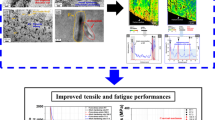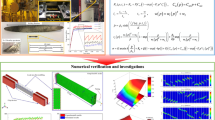Abstract
The deformation behaviors of an Al-Li-Cu alloy (Aluminum 8090) during uniaxial and biaxial stress states were modeled using the nonlinear finite element analysis package ABAQUS 5.8. Two different material models were used for the purpose of comparison and to propose a valid and accurate superplastic material deformation behavior. Using a power law strain hardening model, the material was modeled with either constant or variable properties of strain-rate sensitivity and strain-hardening exponent. Results from the numerical models were compared to experimental results by Chen and Huang, who investigated the uniaxial and biaxial states of stress. Experimental data were primarily used to acquire the needed uniaxial material parameters for the model. The strain-rate sensitivity and strain-hardening exponent were dependent on the strain and strain rates. Comparing the two material models for both stress states indicated that the material model with variable properties better represented the true behavior of the material when compared to the experimental results.
Similar content being viewed by others
References
ABAQUS 5.8 Manual (Pawtucket, RI: ABAQUS, Inc., 1998).
T. Chen and J. Huang, “Hemisphere Free-bulging Behavior of Superplastic 8090 Al-Li Sheets during the Low Strain Regime,” Superplasticity and Superplastic Forming, ed. A. Ghosh and T. Bieler (Warrendale, PA: TMS, 1995), pp. 205–212.
K. Johnson et al., “Accuracy Issues in Modeling Superplastic Metal Forming,” Superplasticity and Superplastic Forming, ed. A. Ghosh and T. Bieler (Warrendale, PA: TMS, 1995), pp. 197–204.
A.H. Chokshi and A.K. Mukherjee, “The Role of Cavitation in the Failure of Superplastic Alloys,” Superplasticity and Superplastic Forming, ed. A. Ghosh and T. Bieler (Warrendale, PA: TMS, 1988), pp. 149–159.
K. Shah and N. Chandra, “Modeling of Superplastic Forming under Axisymmetric and Plane Strain Conditions,” Superplasticity in Aerospace, ed. H. Heikkenen and T. McNelley (Warrendale, PA: TMS, 1988), pp. 135–148.
J. Pilling and N. Ridley, Superplasticity in Crystalline Solids (London: The Institute of Metals, 1989).
I. Ragai, “Finite Element Modeling of Superplastic Forming of High Strength Aluminum Alloy (Weldalite™ 049)” (MS Thesis, American University in Cairo, 2000).
N. Hassan, “Deformation and Limit Strain Analysis of Superplastic Materials Using Finite Elements” (MS Thesis, American University in Cairo, 2001).
Author information
Authors and Affiliations
Additional information
For more information, contact Noha M. Hassan, the American University in Cairo, 113 Kasr El Aini St., P.O. Box 2511, Cairo 11511, Egypt; +202-797-5336; fax +202-797-7565; e-mail nhassan@vt.edu.
Rights and permissions
About this article
Cite this article
Hassan, N.M., Younan, M.Y. & Salem, H.G. The finite-element deformation modeling of superplastic Al-8090. JOM 55, 38–42 (2003). https://doi.org/10.1007/s11837-003-0174-z
Issue Date:
DOI: https://doi.org/10.1007/s11837-003-0174-z




